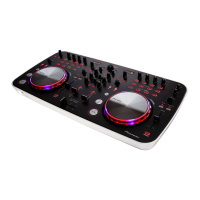
Do you have a question about the Pioneer DDJ-ERGO and is the answer not in the manual?
| Frequency range | 20 - 20000 Hz |
|---|---|
| Channels quantity | 2 channels |
| Digital sound processing | - bit |
| Total Harmonic Distortion (THD) | 0.006 % |
| Microphone in | Yes |
| Master (L, R) out | 2 |
| Dimensions (WxDxH) | 553.7 x 279.4 x 101.6 mm |
| DJ mixer | - |
| Apple docking compatibility | Not supported |
| Weight | 2860 g |
|---|
Describes the unit's design, user appeal, and overall form factor.
Explains the LED illumination features tied to DJ operations and tempo.
Details the laptop dock structure and its usability for positioning.
Introduces the included DJ software and its basic performance capabilities.
Notes that the product supports power supply directly via USB bus.
Describes the unit's rounded body, color scheme, and control layout.
Illustrates a typical DJ system configuration using the unit and peripherals.
Highlights the inherited sound quality technology from Pioneer DJ hardware.
Lists all essential items included with the DJ controller package.
Provides instructions on how to stow the computer's keyboard within the dock.
Explains the procedure for removing and reattaching the unit's feet.
Guides through the process of installing the VIRTUAL DJ LE software.
Details the DJ software application, its features, and compatibility.
Lists the essential system requirements for running the DJ software.
Lists the recommended system specifications for optimal performance.
Step-by-step instructions for installing the DJ software on Windows operating systems.
Step-by-step instructions for installing the DJ software on Mac OS X.
Covers driver details, latest updates, and the software license agreement.
Provides detailed instructions for installing the necessary driver software.
Specifies the supported operating systems for the driver software.
Highlights crucial notes and considerations before starting driver installation.
Guides on physically connecting the DJ controller to a computer via USB cable.
Explains how to adjust the audio buffer size to manage latency.
Details the procedure to verify the installed driver software version.
Identifies and describes the various input/output terminals located on the rear panel.
Details the headphone connection, types of plugs, and impedance requirements.
Illustrates the physical connections for input and output devices to the unit.
Provides an overview of the unit's main control panel layout and key sections.
Explains the browser section used for track selection and library management.
Details the specific controls and operational functions for each DJ deck.
Describes the mixer section controls for adjusting audio levels and blending tracks.
Explains the controls and parameters used for applying audio effects.
Details the sampler functions for playing, stopping, and managing audio samples.
Describes the controls for mixing and applying effects to video playback for visual performance.
Guides on powering up the unit and connected computer for operation.
Instructions for starting the DJ software application on Windows.
Instructions for starting the DJ software application on Mac OS X.
Step-by-step process for loading music tracks onto decks and initiating playback.
Details how to adjust and output audio signals to connected speakers.
Guides on mixing tracks using tempo sliders, channel faders, and the crossfader.
Procedures for safely shutting down the DJ software and the unit.
Explains how to set and utilize cue points for precise track playback control.
Details manual and auto looping features for creating track segment playback.
Describes how to set and trigger hot cues for instant playback initiation.
Describes how to apply and control various audio effects for sound manipulation.
Explains how to use the sampler for playing, stopping, and managing audio samples.
Guides on mixing and applying effects to video playback for visual performance.
Instructions for switching to and utilizing a 4-deck layout for complex mixing.
How to mix external audio sources like microphones and devices into the system.
How to manually adjust beat grids for accurate track synchronization and tempo matching.
Recommends analyzing files to automatically detect BPM and key.
Explains how to change the illumination modes for the jog dials.
Lists MIDI messages for the browser section controls.
Lists MIDI messages for deck controls and basic mixer controls.
Lists MIDI messages for EQ, cue, channel fader, and crossfader controls.
Lists MIDI messages related to the effect controls and parameters.
Lists MIDI messages for the sampler controls and volume.
Lists MIDI messages for the video section controls.
Provides solutions for common operational problems, malfunctions, and recognition issues.
Addresses specific issues like recording, display, software interaction, and CPU usage.
Explains how to use the unit as a controller with alternative DJ software packages.
Lists proprietary trademarks, copyright cautions, and licensing terms.
Details the technical specifications, dimensions, and connectivity of the unit.